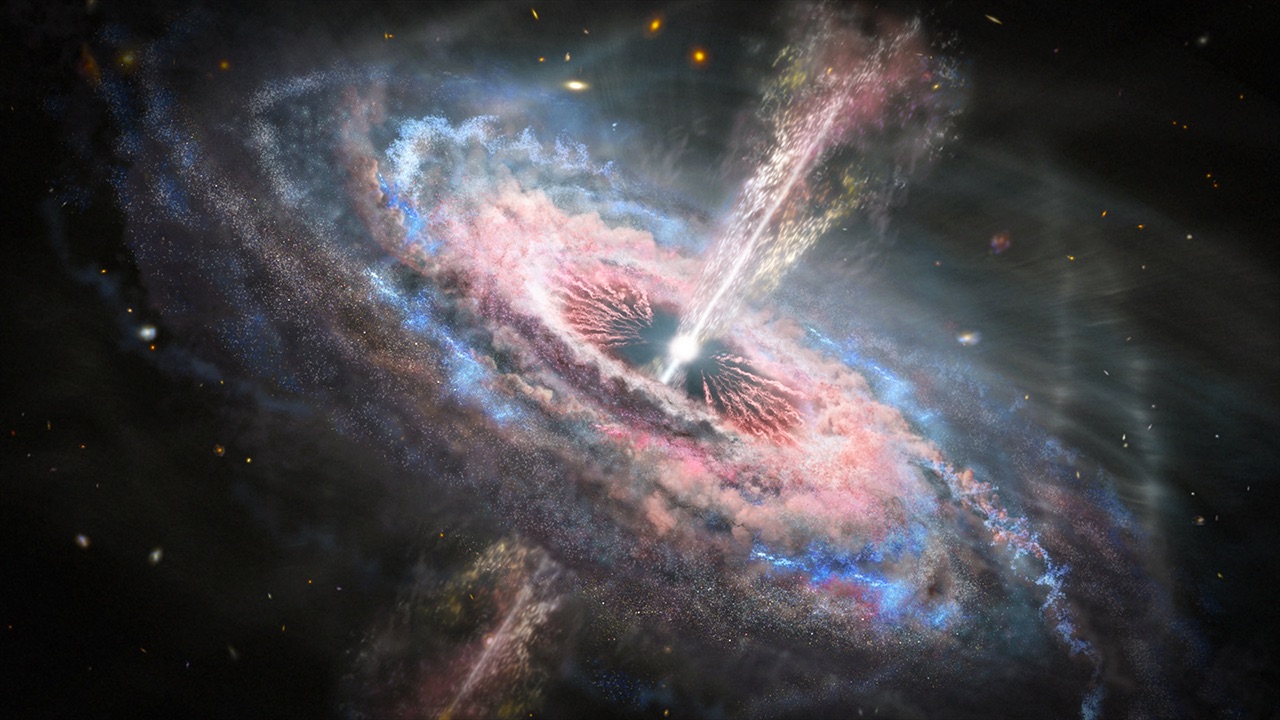Distant 'quasar tsunamis' are ripping their own galaxies apart
The most energetic objects in the universe may be stopping the biggest galaxies from growing bigger.

At the center of almost every galaxy in the universe is a supermassive black hole gobbling up incredible amounts of matter, and belching out incredible amounts of radiation. The biggest and hungriest of these gobblers — called quasars (or quasi-stellar objects, because they look deceptively like stars when seen through most telescopes) — are some of the most energetic objects in the universe.
As infalling matter swirls around the quasar's maw at near-light-speed, that matter heats up and flies outward, propelled by the incredible force of its own radiation. All that intergalactic indigestion makes a quasar an awesome sight, capable of shining a thousand times brighter than a galaxy of 100 billion stars. However, a series of new papers suggests, the very same radiation that puts quasars on our maps of the universe may be devastating the galaxies that host the insatiable objects.
In six studies published March 16 in a special edition of The Astrophysical Journal supplemental series, astronomers used NASA's Hubble Space Telescope to spy on 13 quasar outflows — that is, gusts of high-speed radiation pouring out of distant quasars. By observing the outflows over several years and in many wavelengths across the electromagnetic spectrum, the team found that the wind and gas gushing out of a quasar can travel at more than 40 million mph (64 million km/h) and reach billions of degrees in temperature.
Related: The 15 Weirdest Galaxies in Our Universe
One outflow the team studied accelerated from nearly 43 million mph (69 million km/h) to roughly 46 million mph (74 million km/h) over a three-year period — the fastest-accelerating wind ever detected in space.
This hot, fast gas is capable of causing incredible damage to a quasar's host galaxy, the researchers found, rampaging through the galaxy's disk like a tsunami and blasting potential star-forming material deep into space. In a single year, one quasar outflow can push hundreds of suns-worth of matter into intergalactic space, the researchers found, creating a stunning fireworks display while preventing new stars from forming.
These findings could help answer a long-standing conundrum about our universe: Why do large galaxies seem to stop growing after reaching a certain mass? When the team plugged their new quasar outflow data into models of galaxy formation, they found that the gales of radiation were capable of stunting the birth of new stars in large galaxies.
Sign up for the Live Science daily newsletter now
Get the world’s most fascinating discoveries delivered straight to your inbox.
"Theoreticians and observers have known for decades that there is some physical process that shuts off star formation in massive galaxies, but the nature of that process has been a mystery," Jeremiah P. Ostriker, an astrophysicist at Columbia University in New York and Princeton University in New Jersey not involved in the study, said in a statement. "Putting the observed outflows into our simulations solves these outstanding problems in galactic evolution."
Further study of these mighty outflows, which the researchers believe will only accelerate as their quasars suck in more material, could fill in more details about how the universe's most energetic objects make (and break) entire galaxies.
- 9 epic space discoveries you probably missed in 2019
- The 12 strangest objects in the universe
- 9 Ideas about black holes that will blow your mind
Originally published on Live Science.
OFFER: Save at least 53% with our latest magazine deal!
With impressive cutaway illustrations that show how things function, and mindblowing photography of the world’s most inspiring spectacles, How It Works represents the pinnacle of engaging, factual fun for a mainstream audience keen to keep up with the latest tech and the most impressive phenomena on the planet and beyond. Written and presented in a style that makes even the most complex subjects interesting and easy to understand, How It Works is enjoyed by readers of all ages.

Brandon is the space/physics editor at Live Science. His writing has appeared in The Washington Post, Reader's Digest, CBS.com, the Richard Dawkins Foundation website and other outlets. He holds a bachelor's degree in creative writing from the University of Arizona, with minors in journalism and media arts. He enjoys writing most about space, geoscience and the mysteries of the universe.











